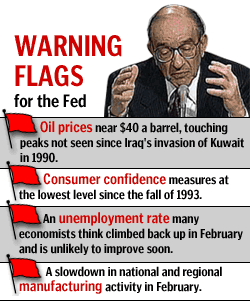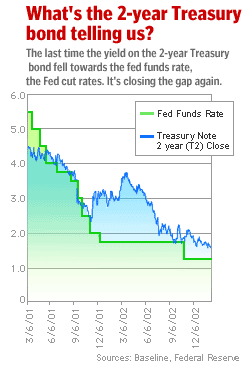NEW YORK (CNN/Money) -
The Federal Reserve wants to wait out a possible war in Iraq before it decides whether or not it needs to cut interest rates to help the economy -- but some analysts worry that the economy needs help now.
The central bank's policy-makers are scheduled to meet March 18 to discuss short-term interest rates, which they can move lower to pump money into the economy in a bid to fend off recession and deflation.

Nobody expects the Fed to cut rates that day, since Fed Chairman Alan Greenspan and other central bankers have been saying for weeks that they think the economy will be fine once the "geopolitical uncertainties" and higher oil prices arising from concerns about a possible U.S.-led war in Iraq are gone.
"The Fed has made it clear that it will take quite ugly news to get them to move in advance of any clarity around the Iraq situation," said Lehman Brothers chief economist Ethan Harris. "That means the March 18 meeting seems too early to expect a cut."
Harris does expect the Fed to cut rates in the first half of this year, either at its May 6 meeting or its June 24-25 meeting, on the belief that the economy will not simply come roaring right back after the Iraq situation is resolved.
"Even with a positive outcome in the war, the economy is going to have lost a lot of momentum by the time it's over," Harris said. "We're not going to see a few weeks of weak data -- we'll see a few months of weak data."
And some economists worry that the Fed is at risk of ignoring the damage already being done by pre-war conditions, including:
- skyrocketing oil prices, which cut discretionary consumer spending and weigh on corporate profits;
- plunging consumer confidence, which by two key measures is at the lowest level since 1993;
- a labor market that's showing no signs of improvement and might actually have worsened in February;
- a manufacturing sector that's slowing down again, including the recent decision by automakers to cut production; and
- stock prices that can't escape from a bear market that's lasted three years and counting.
You don't have to be John Maynard Keynes to realize that, under the weight of all these burdens, the economy's not exactly on a tear during the first quarter.

"Whenever you have a situation where inflation is not a material risk and the economy is underperforming, you should be thinking about a rate cut," said CIBC World Markets senior economist Avery Shenfeld. "There's a potential reward and not much risk."
In fact, U.S. financial markets might already be starting a drum-beat for a rate cut. The yield on the two-year Treasury bond dipped below 1.5 percent Tuesday, a record low that is starting to get closer and closer to the Fed's 1.25 percent target for the federal funds rate, the Fed's key short-term rate.
The spread between 10-year bond yield and the Fed funds rate has also shrunk, another sign that traders are betting that future economic weakness might need to be addressed by lower interest rates.
| Related stories
|

|
|
|
|
"There are a lot of crosscurrents now, but falling yields might indicate that demand for credit is slowing down and that the Fed, by holding the fed funds rate where it is, is actually keeping rates all along the curve from falling to their equilibrium level, or to the level where would they would more naturally go," said Northern Trust economist Paul Kasriel.
So far, the fed funds futures contract, a key indicator of market expectations about future Fed policy, thinks the chances of a March 18 rate cut are extremely slim. But those odds increase throughout the summer, hitting their highest point in July and August.
If the Fed is just going to cut rates anyway, why not do it now instead of later?
For one thing, money supply seems to be holding up pretty well so far, despite the Fed's inaction. And when short- and long-term rates fall on their own as they've been doing, they're pretty much helping the Fed do its job without making another big rate cut that would take the fed funds rate ever closer to zero, at which point the Fed will have to start getting creative.
And with rates already at historic lows, how much more easy credit do we really need at this point?
"The easing the Fed has already done has had a focused and limited effect, mainly on sales of homes and automobiles," said Goldman Sachs senior economist Edward McKelvey. "It's not clear another rate cut will have much effect. I think fiscal easing is more effective at this point; it more directly puts money in people's pocketbooks."
President Bush has proposed a $1.3 trillion plan of tax cuts and spending designed, in part, to help the economy. Democrats have proposed their own, much smaller, fiscal stimulus package designed to pump money directly into the economy.
Greenspan has suggested that both proposals wait until after the Iraq situation is resolved.

|

